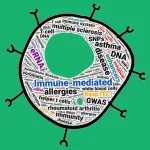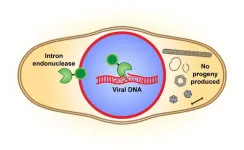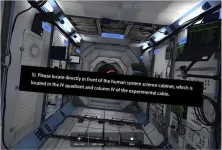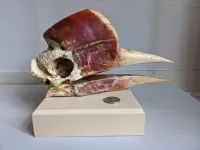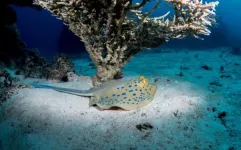(Press-News.org) New research describes for the first time how a spreading wave of disruption and the flow of fluid in the brain triggers headaches, detailing the connection between the neurological symptoms associated with aura and the migraine that follows. The study also identifies new proteins that could be responsible for headaches and may serve as foundation for new migraine drugs.
“In this study, we describe the interaction between the central and peripheral nervous system brought about by increased concentrations of proteins released in the brain during an episode of spreading depolarization, a phenomenon responsible for the aura associated with migraines,” said Maiken Nedergaard, MD, DMSc, co-director of the University of Rochester Center for Translational Neuromedicine and lead author of the new study, which appears in the journal Science. “These findings provide us with a host of new targets to suppress sensory nerve activation to prevent and treat migraines and strengthen existing therapies.”
It is estimated that one out of 10 people experience migraines and in about a quarter of these cases the headache is preceded by an aura, a sensory disturbance that can includes light flashes, blind spots, double vision, and tingling sensations or limb numbness. These symptoms typically appear five to 60 minutes prior to the headache.
The cause of the aura is a phenomenon called cortical spreading depression, a temporary depolarization of neurons and other cells caused by diffusion of glutamate and potassium that radiates like a wave across the brain, reducing oxygen levels and impairing blood flow. Most frequently, the depolarization event is located in the visual processing center of the brain cortex, hence the visual symptoms that first herald a coming headache.
While migraines auras arise in the brain, the organ itself cannot sense pain. These signals must instead be transmitted from the central nervous system—the brain and spinal cord—to the peripheral nervous system, the communication network that transmits information between brain with the rest of the body and includes sensory nerves responsible for sending information such as touch and pain. The process of communication between the brain and peripheral sensory nerves in migraines has largely remained a mystery.
Fluid Dynamics Models Shed Light on Migraine Pain Origins
Nedergaard and her colleagues at the University of Rochester and the University of Copenhagen are pioneers in understanding the flow of fluids in the brain. In 2012, her lab was the first to describe the glymphatic system, which uses cerebrospinal fluid (CSF) to wash away toxic proteins in the brain. In partnership with experts in fluid dynamics, the team has built detailed models of how the CSF moves in the brain and its role in transporting proteins, neurotransmitters, and other chemicals.
The most widely accepted theory is that nerve endings resting on the outer surface of the membranes that enclose the brain are responsible for the headaches that follow an aura. The new study, which was conducted in mice, describes a different route and identifies proteins, many of which are potential new drug targets, that may be responsible for activating the nerves and causing pain.
As the depolarization wave spreads, neurons release a host of inflammatory and other proteins into CSF. In a series of experiments in mice, the researchers showed how CSF transports these proteins to the trigeminal ganglion, a large bundle of nerves that rests at the base of the skull and supplies sensory information to the head and face.
It was assumed that the trigeminal ganglion, like the rest of the peripheral nervous system, rested outside the blood-brain-barrier, which tightly controls what molecules enter and leave the brain. However, the researchers identified a previously unknown gap in the barrier that allowed CSF to flow directly into the trigeminal ganglion, exposing sensory nerves to the cocktail of proteins released by the brain.
Migraine-Associated Proteins Double During Brain Wave Activity
Analyzing the molecules, the researchers identified twelve proteins called ligands that bind with receptors on sensory nerves found in the trigeminal ganglion, potentially causing these cells to activate. The concentrations of several of these proteins found in CSF more than doubled following a cortical spreading depression. One of the proteins, calcitonin gene-related peptide (CGRP), is already the target of a new class of drugs to treat and prevent migraines called CGRP inhibitors. Other identified proteins are known to play a role in other pain conditions, such as neuropathic pain, and are likely important in migraine headaches as well.
“We have identified a new signaling pathway and several molecules that activate sensory nerves in the peripheral nervous system. Among the identified molecules are those already associated with migraines, but we didn't know exactly how and where the migraine inducing action occurred,” said Martin Kaag Rasmussen, PhD, a postdoctoral fellow at the University of Copenhagen and first author of the study. “Defining the role of these newly identified ligand-receptor pairs may enable the discovery of new pharmacological targets, which could benefit the large portion of patients not responding to available therapies.”
The researchers also observed that the transport of proteins released in one side of the brain reaches mostly the nerves in the trigeminal ganglion on the same side, potentially explaining why pain occurs on one side of the head during most migraines.
Additional co-authors Kjeld Mollgard, Peter Bork, Pia Weikop, Tina Esmail, Lylia Drici, Nicolai Albrechtsen, Matthias Mann, Yuki Mori, and Jonathan Carlsen with the University of Copenhagen, Nguyen Huynh and Steve Goldman with URMC, and Nima Ghitani and Alexander Chesler with the National Institute of Neurological Disorders and Stroke (NINDS). The research was supported with funding from the Novo Nordisk Foundation, NINDS, the US Army Research Office, the Lundbeck Foundation, and the Dr. Miriam and Sheldon G. Adelson Medical Research Foundation.
END
Study reveals brain fluid dynamics as key to migraine mysteries, new therapies
2024-07-04
ELSE PRESS RELEASES FROM THIS DATE:
Scientists discover new T cells and genes related to immune disorders
2024-07-04
Researchers led by Yasuhiro Murakawa at the RIKEN Center for Integrative Medical Sciences (IMS) and Kyoto University in Japan and IFOM ETS in Italy have discovered several rare types of helper T cells that are associated with immune disorders such as multiple sclerosis, rheumatoid arthritis, and even asthma. Published July 4 in Science, the discoveries were made possible by a newly developed technology they call ReapTEC, which identified genetic enhancers in rare T cell subtypes that are linked to specific immune ...
The dawn of the Antarctic ice sheets
2024-07-04
In recent years global warming has left its mark on the Antarctic ice sheets. The "eternal" ice in Antarctica is melting faster than previously assumed, particularly in West Antarctica more than East Antarctica. The root for this could lie in its formation, as an international research team led by the Alfred Wegener Institute has now discovered: sediment samples from drill cores combined with complex climate and ice-sheet modelling show that permanent glaciation of Antarctica began around 34 million years ago – ...
Not so selfish after all: Viruses use freeloading genes as weapons
2024-07-04
Curious bits of DNA tucked inside genomes across all kingdoms of life historically have been disregarded since they don’t seem to have a role to play in the competition for survival. Or so researchers thought.
These DNA pieces came to be known as “selfish genetic elements” because they exist, as far as scientists could tell, to simply reproduce and propagate themselves, without any benefit to their host organisms. They were seen as genetic hitchhikers that have been inconsequentially passed ...
Researchers identify unknown signalling pathway in the brain responsible for migraine with aura
2024-07-04
A previously unknown mechanism by which proteins from the brain are carried to a particular group of sensory nerves causes migraine attacks, a new study shows. This may pave the way for new treatments for migraine and other types of headaches.
More than 800,000 Danes suffer from migraines – a condition characterised by severe headache in one side of the head. In around a fourth of all migraine patients, headache attacks are preceded by aura – symptoms from the brain such as temporary visual or sensory disturbances preceding the migraine attack by 5-60 minutes.
While ...
Music: Song melodies have become simpler since 1950
2024-07-04
The complexity of the melodies of the most popular songs each year in the USA — according to the Billboard year-end singles charts — has decreased since 1950, a study published in Scientific Reports suggests.
Madeline Hamilton and Marcus Pearce analysed the most prominent melodies (usually the vocal melody) of songs that reached the top five positions of the US Billboard year-end singles music charts each year between 1950 and 2022. They found that the complexity of song rhythms and pitch arrangements decreased over this period as the average number of notes ...
Effects of visual and auditory instructions on space station procedural tasks
2024-07-04
Firstly, the authors provided a detailed explanation of the experimental methods and procedures. This study recruited 30 healthy subjects (15 males and 15 females), aged between 20 to 50 years, with an average age of 42 ± 6.58 years. All participants had no severe visual or auditory impairments and were right-handed. The subjects met the biometric standards for astronaut candidates and were rigorously screened. The experiment used Unity 3D to model the space station, simulating the internal scenes of the space station. The subjects started from the core node module and found the laboratory module I, where they operated the Space Raman Spectrometer ...
Norway can lead the fight against plastic pollution
2024-07-04
Plastic items from around the world are continuously washing ashore on Norwegian coastlines. This reflects a much larger systemic issue facing the nations of the world.
Scientists have long reported the consequences of plastic pollution and the urgent need for intervention, but global plastic production and consumption continue to rise.
This underscores the importance of Norway’s advocacy for a global agreement that guarantees stopping the flow of plastics into the environment.
But Norway also has a responsibility in generating plastic pollution.
In a study conducted ...
Decolonizing the Tropical Ecology curriculum
2024-07-04
A new study of curriculum reading material at the University of Glasgow finds that 94% of recommended Tropical Ecology authors are white, and that 80% of authors are affiliated with universities outside of the tropics. Dr Stewart White, Senior Lecturer at the School of Biodiversity, One Health and Veterinary Medicine at the University of Glasgow, UK, intends to change that.
“Tropical rainforest research was long the preserve of rich white men and the resulting literature was the same,” says Dr White. “This historical bias in tropical research and publication is still ...
Exploring the casque anatomy of aerial jousting helmeted hornbills
2024-07-04
New research reveals how the surprising internal anatomy of the helmeted hornbill’s casque allows it to withstand damage during aerial jousting battles with rivals. Researchers hope that this new understanding can help to conserve this critically endangered species, as well as provide new insights into developing impact-resistant bio-mimetic materials.
“When I started in Hong Kong, I visited City University of Hong Kong (HKU)’s conservation forensics group to chat about their research and they introduced me to this amazing bird, to its ...
A New Blue: Mysterious origin of the ribbontail ray’s electric blue spots revealed
2024-07-04
Researchers have discovered the unique nanostructures responsible for the electric blue spots of the bluespotted ribbontail ray (Taeniura lymma), with possible applications for developing chemical-free colouration. The team are also conducting ongoing research into the equally enigmatic blue colouration of the blue shark (Prionace glauca).
Skin colouration plays a key role in organismal communication, providing life-critical visual clues that can warn, attract or camouflage. Bluespotted ribbontail ...
